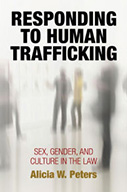Responding to Human Trafficking: Sex, Gender, and Culture in Law

Author: Alicia W. Peters
Publisher: Philadelphia, PA: University of Pennsylvania Press, 2015. 244p.
Reviewer: Barbara Ann Stolz | September 2016
Two recent studies employing qualitative methods provide a macro and micro perspective on the U.S. response to human trafficking. Alicia Peters’ ethnography, Responding to Human Trafficking: Sex, Gender, and Culture in Law,examines beliefs about sex, gender, victimization, crime, and vulnerability as they intersect the drafting, interpretation, and implementation of the 2000 Trafficking Victims Protection Act (TVPA) and its subsequent reauthorizations (2003, 2005, 2008, and 2013). The book seeks to uncover the distinctive meanings that people assign to trafficking and the elements of the TVPA. In Human Trafficking in the Midwest: A Case Study of St. Louis and the Bi-State Area, Erin C. Heil and Andrea J. Nichols explore local responses to human trafficking in Illinois and Missouri. Both studies utilize participant observation and interviews with law enforcement, prosecutors, service providers, and representatives of nongovernmental organizations/advocacy groups as the primary means of data collection. Each study examines human trafficking statutes and the implementation of statutory provisions, albeit in different contexts. Peters focuses on the federal legislation, while Heil and Nichols consider not only federal law but also the state laws of Missouri and Illinois. Both studies attempt to explain the tendency to emphasize sex trafficking in responding to trafficking, despite both sex and labor trafficking falling under the statutes. Additionally, both studies address implications for law in action and future anti-trafficking policy.
For Peters, the central questions at the federal level are: (1) What has led to trafficking’s narrow construction as an issue predominantly about sex? and (2) How does that affect victims of trafficking? To address these questions, the book is organized into three sections. Part I “Trafficking on the Books” focuses on the political conflicts and compromises that led to the TVPA’s definition of trafficking, thereby establishing the legal framework underlying federal-level anti-trafficking policy and practice. Part II “Thinking, Envisioning, and Interpreting Trafficking” explores how various individuals involved in or affected by the implementation of the federal law–law enforcement, prosecutors, service providers, and trafficking survivors–understand trafficking and make sense of the law. Part III “The Law in Action” examines the application of the law. The thread integrating the three sections is the dichotomy between sex and labor trafficking, set out in the law and carried into practice subject to the discretion of the professionals responsible for its implementation.
In Part I, the author concludes that the final legislative compromise defining trafficking led to three dichotomous elements in the TVPA: (1) operative and non-operative definitions of trafficking which purposely conflated prostitution with trafficking; (2) a bifurcated operational definition of trafficking in which trafficking for forced commercial sex was marked as a special category; and (3) separate criminal statutes for sex trafficking and forced labor, which in turn created inconsistencies between who could be considered a victim of trafficking and what could be prosecuted as the crime of trafficking. She further asserts that this dichotomy emerged due to the polarization around the issue of sex-trafficking and significantly influenced the way in which trafficking would be conceived from that point forward. Much of the legislative history of the TVPA will not be new to those who have followed the issue, and some will disagree with the interpretation of the facts. Nevertheless, the summary sets the stage for the author’s discussion of the act’s implementation–the complexities of the law in the minds of those implementing it, resulting in uneven consequences for victims. Additionally, the inclusion of comments from interviews with congressional staffers, a federal policy advisor, and others provides some first-hand perspective on the political dynamics of the time.
No matter how clear and straightforward a law may appear on the books, implementation involves interpretation of the law. Gaps in the law allow for other factors to influence the application of the law by those charged with its implementation. In Part II Peters draws from interviews to illustrate differences between the perspectives of criminal justice and victim service sector professionals on the subject of sex as it relates to trafficking, in particular the “special status assigned to so-called sex trafficking” by law enforcement. Although not generalizable, these vignettes do provide examples of variations in the definition of trafficking as applied in practice. Additionally, Peters presents impressions of survivors, concluding that the bifurcation of trafficking into sex and labor makes no sense when viewed through the lens of lived experience.
Part III explores the law in action, asserting that to implement anti-trafficking measures, service providers and criminal justice authorities have to integrate sometimes-competing understandings of trafficking. She contends that inconsistencies in the law and the discretionary powers of law enforcement agents result in huge meaning gaps in what counts as trafficking and who counts as a victim. Moreover, although implementation conflicts among the many parties could be attributed to the newness of the law and “personalities,” the larger obstacles erupted from the law itself. She underscores that complicated issues required extensive training and paradigm shifts in the years following the law’s passage, particularly among prosecutors and law enforcement agencies. Additionally, she iterates the difficulties with law enforcement reported by the service providers interviewed. The author ends the section on a positive note, including a summary of and commentary on United States v. Carreto, which became a textbook example of multisector collaboration.
The overall strength of the Peters’ book is that it offers food for thought on issues involved in the implementation of law, trafficking or otherwise. Using the ethnographic approach, the study captures the views of those charged with interpreting the law in practice. Accordingly, the book presents what is, not what should be. “What is,” however, is snapshot at a point in time. Generally, the strength ascribed to an ethnographic study is the depth of the description; the weakness is that the analysis is not generalizable to other communities or even a different point in time in the same community. In this instance, the limitation of the study is the evidentiary time-frame, particularly with respect to the interviews, which were conducted between 2006 and 2008; the book was published in 2015. As those familiar with trafficking well-know, issues such as the need for training or collaboration among organizations with diverse perspectives on trafficking may be addressed at one point in time but then recur. Although the need for training, particularly multisector trainings to raise awareness about the complexity of the problem and need for nontraditional alliances, has been recognized, the availability of resources to provide such training ebbs and flows with budgetary fluctuations. Consequently, the long-term importance of the Peters’ book is the questions it raises–questions that may be applied to the continued analysis of federal trafficking legislation, which is subject to reauthorization (every two years by law; periodically, in practice) and its implementation.
In conjunction with the Peters’ book, this reviewer would recommend reading Human Trafficking: A Strategic Framework Could Help Enhance the Interagency Collaboration Need to Effectively Combat Trafficking Crimes (July 2007, GAO-07-915) and the Attorney General’s Annual Report to Congress and Assessment of U.S. Government Activities to Combat Trafficking in Persons. The former highlights efforts undertaken to address concerns raised in the Peters’ book and overlaps with the time period of Peters’ interviews. The latter provides an annual update on U.S. domestic trafficking efforts. Additionally, Janice Raymond’s Not a Choice, Not a Job: Exposing the Myths about Prostitution and the Global Sex Trade, provides a contrasting view on federal legislative events (See review).
Human Trafficking in the Midwest: A Case Study of St. Louis and the Bi-State Area
 Authors: Erin C. Heil and Andrea J. Nichols
Authors: Erin C. Heil and Andrea J. Nichols
Publisher: Durham, NC: Carolina Academic Press, 2015. 234p.
Reviewer: Barbara Ann Stolz | September 2016
On a micro level, the Heil and Nichol book proposes to present a complete picture of sex and labor trafficking evident in this region of the Midwest, specifically the federal districts of the Eastern District of Missouri and the Southwestern District of Illinois. The authors characterize their study as a compilation of voices involved in human trafficking in the St Louis bi-state area–survivors, advocates, and local and federal legal agents. These voices are comprised of a total of thirty-one respondents, representing sixteen organizations derived from a small member-list of St. Louis anti-trafficking organizations and snowball sampling from these sources. The sample consists of survivors (4), social services providers (14), and justice system professionals (17). The picture created includes the definition of human trafficking–sex vs. labor, responses to problem, and challenges to the implementation of the law in this geographic area. The book is divided into two major themes: types of trafficking and responses to human trafficking. To address these themes, the book is organized into seven chapters: Introduction; Labor Trafficking, Sex Trafficking; Policing Human Trafficking; Community Responses to Trafficking: Education, Training, Outreach, and Collaboration: Social Service Provision for Sex Trafficking Survivors; and Implications–for social service providers, law enforcement, education and training, and policy.
In the introductory chapter, the authors begin by laying out the differences in the legal definitions of trafficking found in federal and Illinois and Missouri laws; factors affecting the documentation of the prevalence of human trafficking in the bi-state area, including variations in the laws and misidentification of trafficking victims; research gaps; and methods used in the study. Chapters two and three explore the dynamics of labor and sex trafficking, respectively, in the area. Specifically, the authors look at the types of labor trafficking that occur in agricultural communities in Southern Illinois and Southern Missouri and in the industrial sector of St. Louis. The chapter asserts that labor trafficking is often overlooked by advocates, law enforcement, and policymakers; nevertheless, the victims are trapped in debt bondage with little pay. With respect to sex trafficking, the authors explore (1) the types of sex trafficking occurring in the region, describing it as complex and multifaceted and taking the form of both child pornography and prostitution; (2) risk factors related to structural inequality, weak social institutions, and lack of social safety nets; and (3) trafficking techniques–recruitment, barriers to leaving, and trafficking operations.
Chapters four through seven scrutinize the responses to human trafficking in the bi-state arena. Chapter four examines the legal response by law enforcement and prosecutors; specific training techniques for local and federal law enforcement, including the officers’ perceptions of this training; various avenues of human trafficking investigations; and challenges that arise when prosecuting these cases. Chapter five explores the work of social service and advocacy organizations, the training of professionals in health care, social service, and justice fields, as well as those in service industries likely to come in contact with trafficking victims; collaboration among community organizations; and gaps in all of the areas above. Chapter six focuses on social services provided specifically to sex trafficking victims, looking at the different types of services and related challenges. Chapter seven concludes with a discussion of the implications of the research findings for social service providers and law enforcement in both the areas of labor and sex trafficking. The authors emphasize the need for ongoing education and training, as well as additional types of training and increased availability of services. The chapter closes with policy recommendations and projections for the future of the anti-trafficking movement.
The strength of the Heil and Nichol study is that it offers an in-depth picture of trafficking, as it is in the bi-state St. Louis area. While not generalizable, the study nevertheless suggests avenues for investigation in other communities. For example, by presenting a typology of sex trafficking that reaches beyond prostitution and the simple dichotomy of foreign versus domestic sex trafficking, the study offers a more detailed framework to help identify diverse types of sex trafficking that may exist in a community. Such an analysis should further the understanding of the complexities of sex trafficking, and provide the basis for more directed responses to the particular forms existing in a community. Obtaining recipients’ views on the effectiveness of training should enhance subsequent revisions. Although still limited by time and place, the interviews reported were conducted closer to the publication date and, therefore, the descriptions may still portray the current situation. Nevertheless, as noted in text, mobility is a characteristic of trafficking, making it a moving target, and, therefore, observations about the character of trafficking and responses are likely to change over time.
Taken together, the two studies provide insight into the complexities of trafficking law and federal and state responses by drawing on the experiences and perspectives of policy makers, bureaucrats, implementers–law enforcement and service providers. Specifically, they draw attention to the impact of gaps in the laws, differences in prejudgment views of implementers from different arenas, and the discretion of implementers on those affected by the law–victims of trafficking. While not generalizable, the studies provide a framework of questions that may be applied to the ongoing study of trafficking at all levels and the revision of current federal and state trafficking policy. In conclusion, this reviewer recommends these books to academics, policy makers, and lay persons concerned with the issue of human trafficking.
Barbara Ann Stolz, PhD., adjunct professor at Georgetown University and independent researcher.


